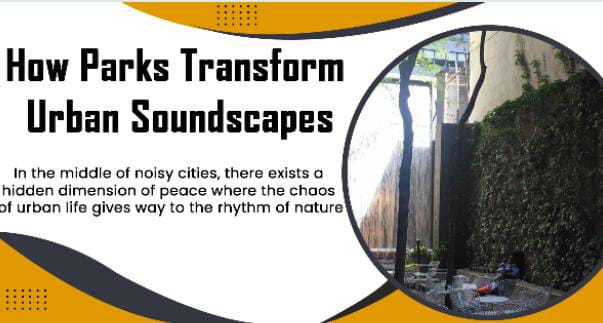
Kenya Williams from Portland: Urban Soundscapes Transformed by Parks
In the middle of noisy cities, there exists a hidden dimension of peace where the chaos of urban life gives way to the rhythm of nature. In this article, we’ll focus on the remarkable influence of parks on the sounds that surround us daily. From the gentle creak of leaves to the soothing chirping of birds, we’ll reveal how these green sanctuaries not only offer respite but also shape the very soundtrack of our urban existence.
What are Urban Soundscapes?
Ever strolled through a city and marveled at the chorus of urban life? Those sounds, whether it’s car horns, laughter, or the distant hum of machinery, come together to form what we call “urban soundscapes.” As cities have grown, so has the bustle of daily life. Kenya Williams from Portland, Oregon, Founder of Hush Soundscape Planning and Design believes that this has profound consequences, not just for what we hear but for our overall well-being. It turns out that the noises we live with on a daily basis have a significant effect on both our psychological and physical well-being. However, our mental state can be positively or negatively impacted by the noisy environment we live in.
The Role of Parks in Urban Environments
Parks are a haven of peace among the skyscrapers and slums, yet they are also an integral part of city life. These green spaces, often ignored, play a vital role in shaping the urban landscape. This section will look at the critical role that parks play in our urban settings.
A. Parks as green lungs in urban areas
These pockets of nature act as vital sources of fresh air in our urban environments. Moreover, they provide a breath of relief, offering a break from the hustle and bustle and an opportunity to reconnect with nature.
B. History and evolution of urban parks
Urban parks have a rich history dating back centuries. They’ve changed from royal hunting grounds and private gardens to public spaces accessible to everyone. Their journey reflects the changing attitudes toward nature, recreation, and community in our cities.
C. Multiple functions of urban parks
- Recreational areas: Parks act as our outdoor classrooms where we can play games of catch, go for walks, or have picnics. Basically, they offer a wide array of activities for individuals and families, promoting physical health and well-being.
- Environmental benefits- Not only do these green spaces benefit people, but the environment as well. Urban parks contribute to cleaner air and water, support local biodiversity, and help mitigate the heat island effect, making cities more sustainable.
- Social and cultural hubs- They host concerts, festivals, and cultural events, fostering social bonds and a sense of belonging. These spaces are the backdrop to our shared experiences and memories.
Transformative Aspects of Parks on Soundscapes
Beyond the lush greenery and play areas, parks have an incredible effect on the sounds that surround us. In this section, Kenya reveal the positive impact of parks as soundscapes.
A. Reduction of Urban Noise:
- Traffic sounds: Trees and greenery act as natural barriers, reducing the impact of traffic noise on the park and its surroundings.
- Construction noise: Further, parks offer a peaceful escape from the clamour of construction sites, providing moments of tranquillity.
- Industrial noise: The industrial buzz that is commonly found in urban areas gives way to a more quiet atmosphere within parks.
B. Social and Cultural Soundscapes:
- Community events and gatherings: Parks host a variety of events, creating social soundscapes filled with laughter, music, and celebration.
- Music and artistic performances: Furthermore, from street musicians to open-air concerts, parks transform into cultural hubs, enriching the city with creative soundscapes.
C. Psychological and Physiological Effects:
- Stress reduction: The calm sounds of nature and the opportunity to escape the urban hustle contribute to reduced stress levels among park visitors.
- Cognitive benefits: Last but not least, a quiet moment in a park can improve focus and mental clarity, providing aural respite for those seeking a break from the city’s constant noise.
Design Principles for Soundscapes in Parks
Designing a natural auditory experience in urban parks is an art form. It’s all about creating the perfect mixture of sounds to enhance your time in the park. In this section, we’ll discuss the fundamental architectural principles that guide the creation of these soundscapes.
- Landscape and Architectural Design: The way the park is designed, with hills, water features, and structures, can affect how sounds travel and interact.
- Planting and Green Infrastructure: Besides that, choosing the right plants and trees can help buffer noise and create a pleasant atmosphere.
- Sound-Absorbing Materials: Using materials that don’t bounce sound, like wood and soft ground coverings, can make a big difference in the park’s acoustics.
- Community Engagement and Feedback: Additionally, involving the local community and listening to their preferences helps shape the park’s soundscape to fit their needs.
These ideas show that the sounds you hear in parks are actually designed to create a calming and enjoyable soundscape, rather than being random noises.
Challenges and Future Considerations
As we cherish the potential of urban parks in shaping our soundscape, it’s important to be aware of the roadblocks they encounter and look towards the future. In this section, we’ll explore the issues that urban parks face and what lies ahead.
- Maintaining and Preserving Urban Parks: Firstly, with cities growing, preserving these havens becomes a challenge. Keeping them around for future generations is a top priority.
- Balancing Human Activities with Nature: Secondly, finding the right balance between people having fun and preserving the environment is necessary for parks to survive.
- Embracing Technology: Thirdly, using tools like sound monitoring can help us better understand and improve park soundscapes.
- Ensuring Equal Access: Lastly, making sure that everyone, no matter where they live or how much they earn, can enjoy urban parks is a big concern.
These factors paint a hopeful picture of what’s ahead for urban parks, stressing the need for smart planning, innovation, and equal access to these city treasures.
Takeaway Points
In the grand urban orchestra, parks play a soothing tune. As we face challenges and explore future possibilities, one thing is clear: these urban sanctuaries are here to stay, as concluded by Kenya Williams from Portland. With smart planning, innovation, and a commitment to inclusivity, parks will keep offering us a harmonious escape from the city’s bustle, making our lives healthier and happier. The future looks bright, with urban parks continuing to be the soothing places we all need.







